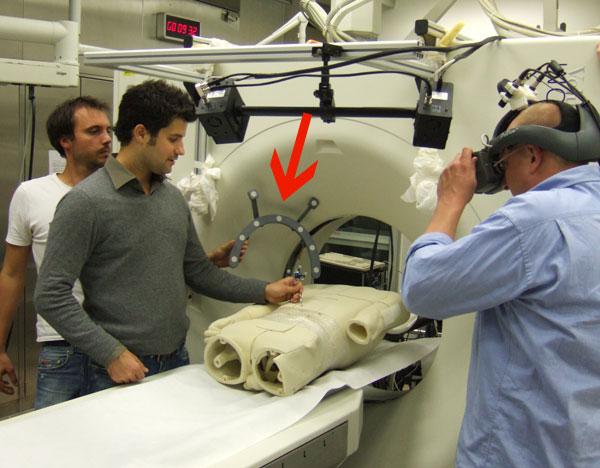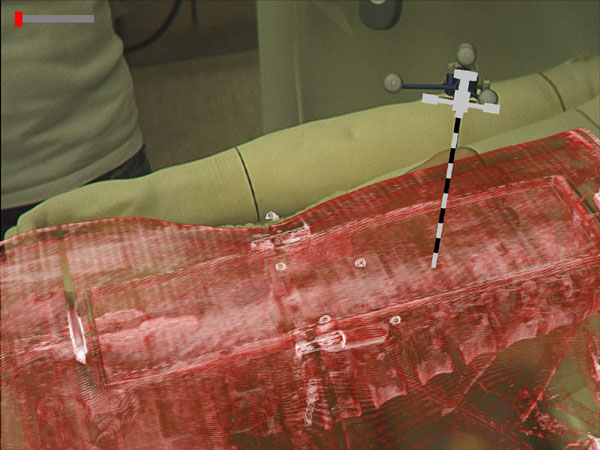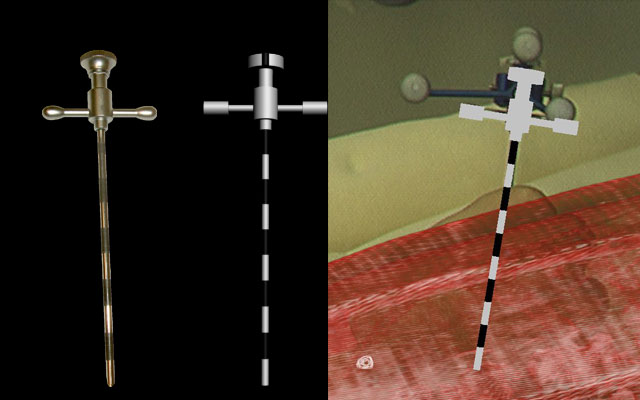Advanced In-Situ Visualization for Vertebroplasty (Bachelor Thesis)
Thesis by: Arno ScherhornAdvisor: Nassir Navab
Supervision by: Christoph Bichlmeier
Due date: 15th October
Abstract
This bachelor thesis concerns the process of bringing over our existing medical augmented reality system from research stage to its first practical use at a real intervention. In today’s medicine, more and more operations are performed using minimally invasive or keyhole surgery. In this technique, all surgical instruments are inserted through a tiny cut in the patient’s skin. As a consequence of this technique, the operating surgeons heavily rely on navigation techniques to compensate for the missing direct view on the operation site. This means that, now, a surgeon has to operate in two locations at the same time: the real operation site and the display of the navigation system that shows him what he is actually doing. This dilemma was the starting point for the navigation and augmented reality visualization (NARVIS) project at the chair for computer aided medical procedures and augmented reality (CAMPAR). The core technology of this project is a medical AR system, consisting of a video see-through head-mounted display (HMD), an optical tracking system and the corresponding software framework, that allows one to visualize anatomical structures in situ. In situ visualization means, that a surgeon, wearing our HMD, sees the virtual anatomical structures exactly where their real counterparts are located. This facilitates him to operate, without constantly switching his focus between the actual operation site and the display of the navigation system. This allows a very natural operation procedure with all the advantages that modern navigation systems offer. Although much research has been invested in the possibilities and challenges of such a medical augmented reality system, there has never been a project that tried to compile all the results and tailor the system for one specific operation. Based on a suggestion from one of our cooperating surgeons at the Klinikum Innenstadt, the vertebroplasty intervention was chosen to be this first target operation. In my work, I analyzed the vertebroplasty and the existing AR system. Then, I formulated a research vision of how our technology could be used in this operation. Based on the research vision, I further analyzed what research and development steps needed to be taken. After developing this outline, I started my research and development work in the most important or unexplored areas. To evaluate and further analyze the operation and the progress of the AR system, my supervisor and I conducted an experiment at the beginning and at the end of my thesis work. Furthermore, I surveyed surgeons from Klinikum Innenstadt, to measure their acceptance of the system, define development priorities, and explore new possibilities for our technology.Schedule
Date  | Event |
|---|---|
| ... | ... |
| 06.05.2007 | First Operation Visit |
| 08.10.2007 | Post-Experiment |
| 15.05.2007 | Start |
| 15.10.2007 | End |
| 19.10.2007 | Final Presentation |
| 27.06.2007 | Kick-Off Presentation |
Resources
Literature
- Image from our Post-Experiment, Red Arrows points out critical position of RAMP-Arc:

- Image from our Post-Experiment:

- Real Trocar, Virtual Trocar and Combination of Both in Post-Experiment:

| Students.ProjectForm | |
|---|---|
| Title: | Advanced In-Situ Visualization for Vertebroplasty |
| Abstract: | This bachelor thesis concerns the process of bringing over our existing medical augmented reality system from research stage to its first practical use at a real intervention. In today’s medicine, more and more operations are performed using minimally invasive or keyhole surgery. In this technique, all surgical instruments are inserted through a tiny cut in the patient’s skin. As a consequence of this technique, the operating surgeons heavily rely on navigation techniques to compensate for the missing direct view on the operation site. This means that, now, a surgeon has to operate in two locations at the same time: the real operation site and the display of the navigation system that shows him what he is actually doing. This dilemma was the starting point for the navigation and augmented reality visualization (NARVIS) project at the chair for computer aided medical procedures and augmented reality (CAMPAR). The core technology of this project is a medical AR system, consisting of a video see-through head-mounted display (HMD), an optical tracking system and the corresponding software framework, that allows one to visualize anatomical structures in situ. In situ visualization means, that a surgeon, wearing our HMD, sees the virtual anatomical structures exactly where their real counterparts are located. This facilitates him to operate, without constantly switching his focus between the actual operation site and the display of the navigation system. This allows a very natural operation procedure with all the advantages that modern navigation systems offer. Although much research has been invested in the possibilities and challenges of such a medical augmented reality system, there has never been a project that tried to compile all the results and tailor the system for one specific operation. Based on a suggestion from one of our cooperating surgeons at the Klinikum Innenstadt, the vertebroplasty intervention was chosen to be this first target operation. In my work, I analyzed the vertebroplasty and the existing AR system. Then, I formulated a research vision of how our technology could be used in this operation. Based on the research vision, I further analyzed what research and development steps needed to be taken. After developing this outline, I started my research and development work in the most important or unexplored areas. To evaluate and further analyze the operation and the progress of the AR system, my supervisor and I conducted an experiment at the beginning and at the end of my thesis work. Furthermore, I surveyed surgeons from Klinikum Innenstadt, to measure their acceptance of the system, define development priorities, and explore new possibilities for our technology. |
| Student: | Arno Scherhorn |
| Director: | Nassir Navab |
| Supervisor: | Christoph Bichlmeier |
| Type: | Bachelor Thesis |
| Area: | Medical Augmented Reality |
| Status: | finished |
| Start: | 2007/05/15 |
| Finish: | 2007/10/15 |